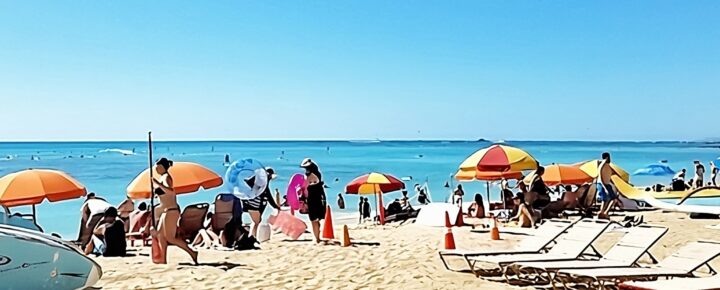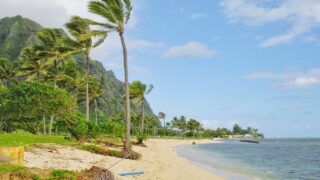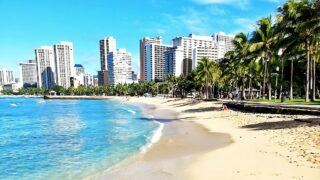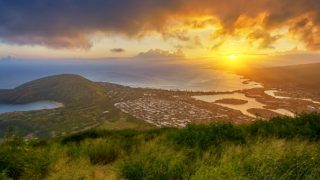The void left by Japanese visitors, who have long been integral to Hawaii tourism, has compounded the challenges facing the state. As the focus shifts increasingly to visitors from the U.S. mainland, opportunities arise to redefine tourism and build a more resilient future. However, this transition has hurdles, including rising costs and changing visitor expectations.
Hawaii’s tourism engine is navigating a major transformation as its top international market, Japan, faces a much more prolonged recovery. Economists at the state’s research arm, UHERO, now predict that visitor arrivals from Japan may not return to pre-pandemic levels at any point this decade. This slow rebound raises critical questions about how Hawaii’s tourism economy can adapt and thrive without its historically strong Japanese market.
These struggles highlight the urgency for Hawaii to secure the resources needed to navigate this transformation effectively. The state recently declared a tourism emergency and sought to utilize its $5 million Tourism Emergency Special Fund to address issues like economic recovery, which echoes the urgent calls for support after the tragic wildfires in Lahaina and the devastating fires in California.
Hawaii’s reliance on domestic visitors must now balance with ensuring their experiences are positive and aligned with a sustainable vision for tourism. Hawaii Emergency Funds Court SF and LA Visitors.
Strong hopes for a rise in U.S. visitors.
Los Angeles, Hawaii’s largest source city, has consistently contributed generously to visitor numbers but is now facing the devastating aftermath of its tragic recent fires. In the first eleven months of 2024, nearly 9 million visitors arrived in Hawaii, with over 2.6 million coming from California alone. U.S. visitors remain the backbone of Hawaii’s tourism recovery, now more than ever.
Recognizing the importance of this connection, Governor Josh Green proposed measures to support Californians affected by recent fires. One plan proffered involves offering temporary Hawaii hotel rooms for survivors who lost their homes. The governor hopes this could help ease the resultant housing crisis while utilizing Hawaii’s vacant hotel rooms. Costs are to be covered by insurance or FEMA.
In addition, the governor proposed his “Aloha for LA” initiative to offer free flights and discounted hotel stays for California first responders to help decompress post-fires. This initiative, in concert with the airlines flying to Hawaii and others, could further solidify Hawaii’s bond with its largest visitor market while emphasizing a spirit of aloha during challenging times somewhat reminiscent of Hawaii’s own recent tragic fires.
Japan’s lagging recovery.
Visitor arrivals from Japan totaled about 700K in 2024, which is less than half the number seen in 2019. Reasons cited for the slower-than-expected return include a weak yen, inflation, and shifts in travel behavior. Some have said that Japanese visitors are also less Hawaii-centric than once was true. It’s hoped that Japanese arrivals might reach one million this year, but a full recovery remains uncertain.
To navigate this gap, Hawaii’s tourism industry still focuses on some niche Japanese markets, including high-end travelers, group tourism, and the Japanese wedding industry. These segments provide opportunities to grow revenue even while the overall numbers remain depressed.
Opportunities to diversify tourism.
The slower recovery in Japan continues to spark a broader conversation about diversification within Hawaii’s economy. Beyond the U.S. and Japan, we have Canadian and South Korean markets that could help reduce reliance on California, for example. Within the U.S., efforts to promote neighbor island tourism and cater to domestic travelers are also expected to now expand.
Meanwhile, industry leaders are leveraging this period to innovate. Programs continue to emphasize eco-tourism, Hawaii cultural immersion, and other growing segments of “conscious” travelers. These efforts aim to balance visitors’ needs with preserving Hawaii’s unique environment and culture.
Building resilience for the future.
Hawaii’s tourism challenges underscore the importance of adaptability. The state wants to chart a path to long-term resilience by leaning into its strengths and embracing new markets. While Japan’s recovery may take years, the lessons learned during this period will help shape a more dynamic and sustainable tourism industry.
Other lessons, like the tragic Los Angeles fires, also speak to a need for more diversification in Hawaii travel marketing.
The pivot to U.S. visitors this time is not just a stopgap—it’s a long-term opportunity to develop a stronger foundation for the future of Hawaii tourism.
We welcome your comments.
Get Breaking Hawaii Travel News







We traveled to Kona last year and loved it vowing to return. However, when we heard how parking went up to over $20 after we left we are reevaluating returning. Another barrier is the war on Airbnbs in Hawaii. It’s just one more restriction on us having the vacation we want to have.
I’m a travel RN with family in Hawaii. I would take a contract and spend money while there seeing the sights if the contracts were available and the housing was more affordable and in line with the pay offered.
I think it is really gross going after California fire victims for a gain for Hawaii. I find it disgusting.
Hawaii just doesn’t get it, do they? Drop the ban on STR’s, lower your prices, and maybe call a ceasefire on the added fees and restrictions being thrown at tourists. We’re not to blame for your problems and don’t want to go where we’re clearly resented. It’s a pretty basic concept—treat the tourists nicely and we’ll come back.
Biggest problem is that governments at all levels are addicted to the taxes and fees they collect. This isn’t unique to Hawaii; it’s a global phenomenon. Tourism often becomes a significant revenue stream, and rather than managing it sustainably, governments sometimes push for short-term financial gains at the expense of long-term goodwill.
Brilliant plan by the governor: after telling US mainland visitors don’t come and scare them away from STRs. Now realizes where the majority of the states needed visitors come from? And spend extra states money on now trying to convince them to come? Governor is sure in the pocket of big hotels (who profited lots housing survivors) to suggest now have them fill ’empty hotel rooms’ with CA victims (at all of us expense through FEMA). He sure does the big hotels proud…
As of 2023 Japan’s national debt is 9.2 Trillion dollars that doesn’t sound so bad next to our 36 Trillion dollars, but it’s 268 percent of their GDP one of the highest debt percentages of any developed country.
As has been reported by several outlets “According to recent reports, Japan is currently experiencing a recession, with its economy contracting for two consecutive quarters, primarily due to a shrinking population, weak domestic demand, and a weakening yen, causing it to lose its position as the world’s third-largest economy and fall behind Germany; this situation is often referred to as “the Lost Decade” due to prolonged economic stagnation.”
This on top of Japan’s population is old and shrinking by 800,000 a year means a return of Japanese visitors to Hawaii in any numbers as in the past is wishful thinking at best.
All Hawaii has to do is stop all of the posturing and messaging about banning STRs. The thousands of posts I’ve read on this website alone saying “If no STRs, I won’t be returning” shows that visitors will all return with gusto if all of the idiotic rhetoric stops.
Instead of soaking US taxpayers + FEMA, Hawaii hotels should simply lower their prices to fill their rooms. And timeshares + hotels should dump the resort fees (for nothing other than a pool). And car rentals can lower their prices. That will bring more people to the islands to spend money.
stupid idea to bring LA fire victims to Hawaii